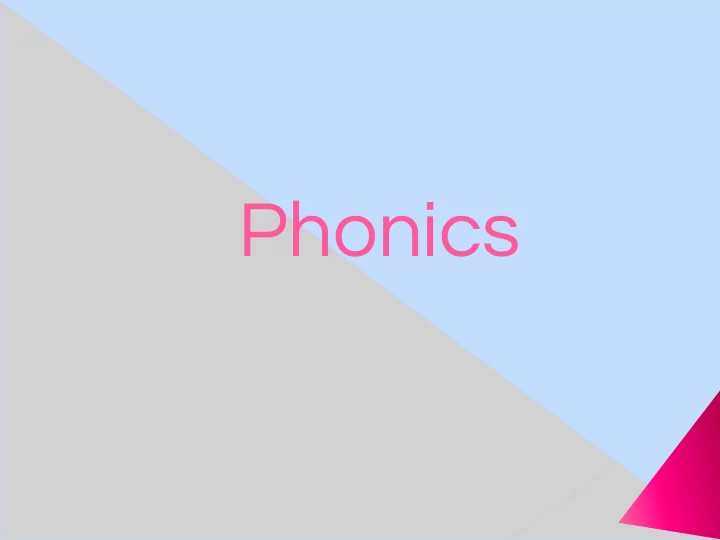

Phonics
Aims By the end of this workshop you will: - have a greater understanding of how and why we teach phonics - be able to support your child when sounding out unknown words - explore ways in which we support children in their learning, including methods you can use at home.
What is Phonics? Phonics is a method of teaching children to read and spell. Phonics teaches children to listen and identify sounds within a word.
Why we teach phonics? There are 1000’s of words in the English language – it would be quite a challenge to remember all of these words! We have a choice when teaching reading and spelling, we can memorise or teach phonics. When we teach phonics, we provide a reading foundation that is based on letters and sounds of the alphabet. Learning in this way gives children the tools to break words down and read words that are unfamiliar.
Phonics in the British Curriculum Teachers should build on work from the... (previous year)...making sure that pupils can sound and blend unfamiliar printed words quickly and accurately using the phonic knowledge and skills that they have already learnt. Teachers should also ensure that pupils continue to learn new grapheme-phoneme correspondences (GPCs) and revise and consolidate those learnt earlier. The understanding that the letter(s) on the page represent the sounds in spoken words should underpin pupils’ reading and spelling of all words.
Reading in Year 1
Sounds Some sounds are made from single letters e.g. m – a – t (this is a CVC word) Others are created by two or three letters that group together to make a single sound. e.g. sh – i – p (‘sh’ is a digraph) n – igh – t (‘igh’ is a trigraph) c-a-k-e (‘a-e’ is a split digraph)
Articulation of phonemes http://www. oxfordowl.co.uk/for- home/phonics- made-easy http://www.youtube.com/watch?v=BqhXUW_v-1s
What is a sound button? fish dog fire night Robot talk it!
How many sounds?
Sound buttons - Foundation 2
The next step…the tricky bit! One example of this is the ee sound which can be made in the following ways ee - need ea - weak y - happy e -e - these Not to be confused with the ‘y’ that can make ‘i’ as in ‘fly’ Or the ‘ea’ that can make ‘e’ as in ‘bread’ Sometimes the same spelling pattern makes a variety of different sounds. e.g. ough ‘ough’ in ‘plough’ makes the ‘ow’ sound. ‘ough’ in ‘rough’ makes the ‘u’ sound. ‘ough’ in ‘through’ makes the ‘oo’ sound.
Phonics in Year 2
Letters and Sounds Phase One (F1/F2) Activities are divided into seven aspects, including environmental sounds, instrumental sounds, body sounds, rhythm and rhyme, alliteration, voice sounds and finally oral blending and segmenting. Phase Two (F2) Learning 19 letters of the alphabet and one sound for each. Blending sounds together to make words. Segmenting words into their separate sounds . Phase Three (F2) The remaining 7 letters of the alphabet, Graphemes such as ch, oo, th representing the remaining phonemes not covered by single letters. Reading captions, sentences and questions. Phase Four (F2/Y1) No new grapheme-phoneme correspondences are taught in this phase. Children learn to blend and segment longer words with adjacent consonants, e.g. swim, clap, jump.
Phase Five (Throughout Year 1) Now we move on to the "complex code". Children learn more graphemes for the phonemes which they already know, plus different ways of pronouncing the graphemes they already know. Phase Six/Support for Spelling (Throughout Year 2 and beyond) Working on spelling, including prefixes and suffixes, doubling and dropping letters etc.
Jolly Phonics Used in conjunction with Letters and Sounds to support children learning initial letter sounds
Jolly Phonics Jolly Phonics includes actions and songs helping children to learn in different ways. http://www.youtube.com/watch?v=eCjJYB07aSU
Websites http://mrthorne. com/home/phonics/geraldine-the-giraffe/ http://www.bbc.co. http://www.phonicsplay.co.uk/ uk/bitesize/ks1/literacy/phonics/pl ay/
Apps Hairy Letters Little Writer Forest Phonics
Points to remember Letters have names and phonemes. It is preferable that children make phonetically plausible attempts at reading and spelling when learning, rather than being told how to read or spell the word. If the child can’t say it then they can’t write it. Children need sound out aloud or verbalise the sentence before they write it (in early stages of writing development)
Q&A Questionnaire
Recommend
More recommend